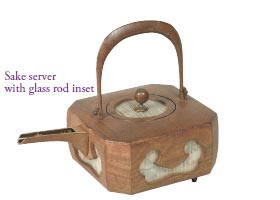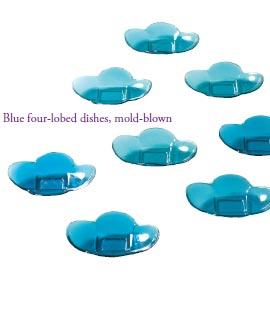
warblers on a plum branch in their hair. Women had beaded sewing cases. On the verandas, the chirping of insects could be heard from insect cages inserted with fine glass rods. On the edges of the eaves hung glass goldfish bowls with crimson goldfishes swimming peacefully inside. People went on outings with portable multi-tiered food containers furnished with glass sake decanters and food boxes adorned with beads.
Daitō also valued shape. The quintessential Japanese shapes, to him, can be seen in the Blue tall-necked sake flask with its long, slender neck known as tsurukubi, or crane’s neck, and the Purple tea bowl. He explains, “The unadorned simplicity and beauty come from the absence of technique. Japanese glass possesses a sense of modesty and reserve that is elegant.”
Texture was another features that Daitō placed great importance on. Many Japanese value the feel of materials such as the surface of ceramic ware or the grain of woodworks. The same aesthetic sensibility is applied to the surface of biidoro. Colorless biidoro appear slightly yellowish-green. When molten glass is placed into the cold mold, the glass hardens and slightly shrinks, resulting in a soft fluctuation on the surface. The Melon-shaped vessel with cover is a representative example of this. Its indescribable softness feels as though it will melt away in your hands.
Japanese glass also comes in a variety of colors. The plates and bowls, which can enchant merely with their chic colors—yellow, green, blue, indigo, purple, brown—and their uneven shapes, are truly simple and beautiful. The Bindeisha Collection is distinctive for its sets of dishes such as an usual ten-set biidoro mukozuke bowls.
Daitō also valued shape. The quintessential Japanese shapes, to him, can be seen in the Blue tall-necked sake flask with its long, slender neck known as tsurukubi, or crane’s neck, and the Purple tea bowl. He explains, “The unadorned simplicity and beauty come from the absence of technique. Japanese glass possesses a sense of modesty and reserve that is elegant.”
Texture was another features that Daitō placed great importance on. Many Japanese value the feel of materials such as the surface of ceramic ware or the grain of woodworks. The same aesthetic sensibility is applied to the surface of biidoro. Colorless biidoro appear slightly yellowish-green. When molten glass is placed into the cold mold, the glass hardens and slightly shrinks, resulting in a soft fluctuation on the surface. The Melon-shaped vessel with cover is a representative example of this. Its indescribable softness feels as though it will melt away in your hands.
Japanese glass also comes in a variety of colors. The plates and bowls, which can enchant merely with their chic colors—yellow, green, blue, indigo, purple, brown—and their uneven shapes, are truly simple and beautiful. The Bindeisha Collection is distinctive for its sets of dishes such as an usual ten-set biidoro mukozuke bowls.






The Blue four-lobed dishes were collected separately in a set of
four and a set of five—one of which formerly
belonged to the author and collector Masako Shirasu (1910–1998).
Among the faceted works in this collection include the Satsuma kiriko copper red overlay glass bowl with cross design, which possesses the irregularities that can often be seen in Japanese red glass, the Purple kiriko lidded bowls are breathtakingly sublime on the inside. The Sake server with glass rod inset, which merges the lacquer technique of maki-e (sprinkled metal design) and glass rods with the finest of craftsmanship, and Octagonal, two-tiered sweets server (jikirō), flamed glass, made by the eighth generation Jōeki Nakagawa (1830–1877), one of the ten crafts families of Senke tea schools, exhibit the high degree of technical skill of the artisans. Six-panel screen of fish swimming and glass rod base, which combines glass with the painting of Raishō Nakajima (1796–1871), the Maruyama school painter, exudes a Japanese sensibility of coolness.
In describing the process of collecting, Norisato Daitō explained, “When I encounter works of fine biidoro, my heart just about explodes. Rather than thinking rationally with my head, my whole being is moved.” We hope that you will enjoy the beauty of Japanese glass, which blossomed in the Edo period.
Among the faceted works in this collection include the Satsuma kiriko copper red overlay glass bowl with cross design, which possesses the irregularities that can often be seen in Japanese red glass, the Purple kiriko lidded bowls are breathtakingly sublime on the inside. The Sake server with glass rod inset, which merges the lacquer technique of maki-e (sprinkled metal design) and glass rods with the finest of craftsmanship, and Octagonal, two-tiered sweets server (jikirō), flamed glass, made by the eighth generation Jōeki Nakagawa (1830–1877), one of the ten crafts families of Senke tea schools, exhibit the high degree of technical skill of the artisans. Six-panel screen of fish swimming and glass rod base, which combines glass with the painting of Raishō Nakajima (1796–1871), the Maruyama school painter, exudes a Japanese sensibility of coolness.
In describing the process of collecting, Norisato Daitō explained, “When I encounter works of fine biidoro, my heart just about explodes. Rather than thinking rationally with my head, my whole being is moved.” We hope that you will enjoy the beauty of Japanese glass, which blossomed in the Edo period.













